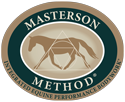What if my horse is constantly fidgeting? What if he appears uncomfortable and wants me to stop?”
Often when we find something in the horse that’s uncomfortable, he’ll fidget, or he’ll tell us it’s uncomfortable. This is part of the communication. When that happens, we have to find the right level of pressure or non-pressure, or space to make it comfortable for the horse to release. He might mess with the handler, or even try to nip. As you practice this more, you’ll start to learn how to read through that behavior. Soften or even back your hand farther away, but whenever possible be patient and stay with it and give him a chance to work it out. When he releases it will be worth it. Then carry on.
When you have a horse that won’t hold still even before starting the first thing you want to do is give him a chance to settle. Don’t just go right to work. Keep the horse on a loose lead and let him walk in circles around you until he settles down. Just ask him to “stay in the neighborhood”, give him a chance to get used to what’s going on. That’s the first thing, and that’s usually the most effective. Just the effect of waiting and giving the horse time to settle and resist going right for what might be bothering him is going to help him to release tension.
From the transcript – “Now, I’m going to start. I don’t think this horse is just going to stand for everything, so this’ll be a good opportunity to see how to handle it. He’s a little mouthy because often horses that are uncomfortable are mouthy, but he’s letting some of it go. I’m going to start with the Bladder Meridian technique. I’m going to keep a loose hand on his lead rope unless he gets nippy. I won’t correct his nippiness unless he actually connects with his teeth. Then I’ll correct the behavior, but I’ll do it immediately and clearly and just once.
With this horse I’m going to start behind the poll, not on top where he’s head shy. If the horse is uncomfortable in one area, then move to an area where he can handle it. Then come back to the uncomfortable area after he’s relaxed and released some tension.
Remember also that the more tense you are, the harder time you’re going to have, so keep your arms soft and your hands soft. I’m going to start even farther down from his poll because that’s where it’s comfortable for him, and let him get used to that.
The first defense against having a horse get upset is to go soft enough and slow enough. Now he’s feeling something right in here. I’m going to stay in here with just my palm, barely touching and give him a chance to let some of that go. Then we’re going to work our way back up to his poll. You don’t want to start where it’s the most uncomfortable for the horse. You want to start where it’s more comfortable for the horse and then go to the more difficult areas after he’s relaxed and released some tension.
If he moves, keep your hand with him and walk with him. Just walk. When you’re working in the stall, he can only back up so far, so stay lightly with him. If you’re working in an open area then just let him walk in a circle and walk with him with your hand in place until he stops. If he continues to circle or gets even more energetic, then you can stop him, let him clam for a second then pick up where you left off. You can stop at any time and pick up where you left off; you don’t lose any ground when you stop.”
